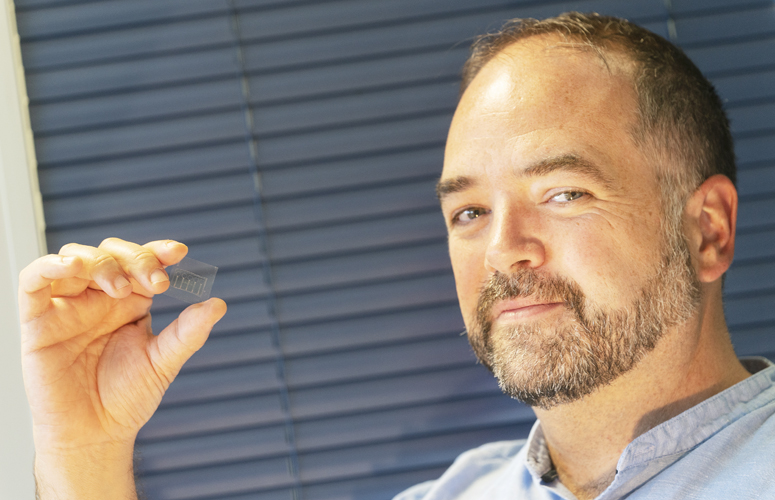The UPV/EHU's Microfluidics Cluster has used a custom-made resin formulation coupled with a high-resolution 3D printing methodology for the rapid optimisation of modular plasma separation devices working with very small sample sizes. The printing method used demonstrates the huge contribution that this microfluidic technology can make towards the market for biomedical plasma separation devices.
A micrometric blood plasma separator using high-resolution 3D fabrication
Researchers at the UPV/EHU-University of the Basque Country have developed a microfluidic plasma separator to optically detect blood biomarkers
- Research
First publication date: 09/12/2022

Within the framework of devices of the ‘Lab-on-a-Chip’ type, which integrate one or more laboratory functions into a single millimetre-sized chip, diagnostic tests to determine biomarkers in blood are being successfully developed. The improvements that microfluidics can bring to medical devices and analysis are hugely significant because they make it possible to work with very small quantities and get the same results.
3D printing has had a significant impact on this field, although the development of fully functional 3D printed microfluidic platforms with built-in components remains a challenge. The UPV/EHU’s Microfluidics Cluster has done its bit in this respect.
Blood cells interfere with many biomarker determinations, leading to inaccurate concentration values. So plasma separation is a critical step towards improving analytical performance and developing reliable, accurate detection systems. In a piece of research published by the scientific journal 'Polymers', the PhD student in the UPV/EHU’s Microfluidics Cluster Sandra García-Rey used a custom-made resin formulation combined with a high-resolution 3D printing methodology to achieve the rapid prototype optimisation of an operational plasma separation module.
A major contribution towards the market for biomedical plasma separation devices
“Imagine a channel measuring about five or ten microns,” explained Dr Fernando Benito-López, one of the cluster’s lead researchers, “whose surface is functionalised with receptors to capture a certain molecule, or biomarker, from the blood and analyse it using fluorescence. Red blood cells would prevent the fluorescence from being seen. So we have created a kind of hole in which the white and red blood cells are removed by gravity; that way, only the plasma passes through the channel, and any interference that might occur in the integrated optical detection system is eliminated. In other words, this module would be positioned in front of the analysis system”. According to Benito-López, this new system allows the entire process to be integrated into the fluidic device. What is more, the device improves the quality of the analysis, “because it is faster, and there are fewer errors because there is less human intervention”.
The microfluidic device produced to separate plasma from blood easily and reliably has demonstrated the potential of stereolithographic 3D printing technology for microfabrication (laser technology using a liquid resin sensitive to UV light). “An optimal fluidic structure can be achieved much faster than by using conventional methods, such as photolithography,” said Dr Benito-López. The researchers say this research will facilitate the production of one-piece 3D-printed devices fitted with integrated plasma separation components and which are designed to detect biomarkers in the blood. They also demonstrated that “it is possible to work with different resins”.
Additional information
This research is part of the DNASURF European project coordinated by the University of Newcastle (United Kingdom), and in which various partners from Europe are collaborating. This is a project in the RISE call which promotes the exchange of knowledge between research groups in Europe and research groups in other parts of the world; this enabled the UPV/EHU researcher Sandra García-Rey to conduct this study at the Brigham Young University (Utah, United States).
Bibliographic reference
- High-Resolution 3D Printing Fabrication of a Microfluidic Platform for Blood Plasma Separation
- Polymers
- DOI: 10.3390/polym14132537



